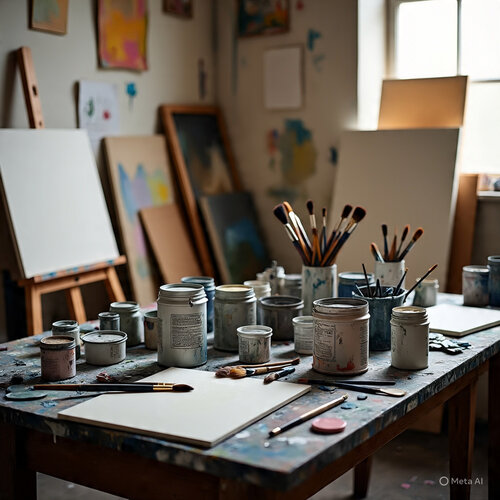by Carolyn Edlund
Secure your studio business with safer art materials, storage, and disposal methods.

For a lot of artists, the studio is a sanctuary for creativity and self-expression. But behind all those paints, solvents, and glues that help create your art, there are often lurking dangers. Harmful ingredients, poor storage habits, and improper disposal can affect health, endanger your workspace, and harm the environment. The good news? A few smart adjustments can boost your studio’s safety without sacrificing your artistic vision.
Recognize the hidden dangers of art supplies
It’s easy to overlook that many everyday art materials are actually industrial chemicals. Traditional oil paints can contain heavy metals such as cadmium, lead, or cobalt. Solvents like turpentine and mineral spirits emit volatile organic compounds (VOCs) that irritate your lungs and can lead to headaches. Plus, aerosol sprays, varnishes, and certain adhesives can release fumes that gather in spaces without good ventilation. Even those products labeled as “low odor” can pose health risks with long-term use.
Regular contact with these substances can lead to respiratory issues, skin irritation, or even more serious health problems. The first step is awareness. Knowing what’s in your stash of art supplies allows you to take the necessary precautions.
Opt for safer alternatives
Luckily, artists today have access to a wider variety of non-toxic options than ever before. Water-based paints and mediums do away with the need for harsh solvents. Acrylics can replace oils, providing vibrant colors while reducing contact with harmful ingredients. Eco-friendly adhesives and low-VOC sprays are easily found. When shopping for new materials, check for non-toxic certifications (like ACMI’s AP Seal) and look over Safety Data Sheets (SDS) for more info.
Making the switch to safer products not only cuts down on your exposure but can also create a more enjoyable and eco-conscious studio environment.
Implement smart storage practices
Even with safer options, good storage is essential. Always keep chemicals in their original containers and label anything you transfer. Flammable materials should go in a metal cabinet meant for that purpose, away from heat sources. It’s also a smart move to keep incompatible chemicals apart—for example, acids and solvents shouldn’t share the same space.
If pets, kids, or visitors come into your studio, take extra precautions. Lock up cabinets and keep hazardous items out of reach. And remember, a clean, organized workspace makes it easier to avoid spills and accidents.
Dispose safely and be environmentally responsible
One of the most common mistakes artists make is mishandling chemical disposal. Never pour solvents down the drain or in the trash, as this can lead to fires or contaminate groundwater. Instead, collect used solvents in a sealed container and take them to a community hazardous waste facility. Many towns have collection days for paints, solvents, and other chemicals.
Also, keep in mind that oily rags can pose risks too. If left in a pile, they can catch fire spontaneously. To avoid this, store used rags in a sealed metal container filled with water and dispose of them through a hazardous waste program. By managing disposal responsibly, you’re protecting not only your health but the environment as well.
Practice safe studio habits
Beyond safer products, storage, and disposal, your personal habits can make a huge difference. Always wear gloves when handling solvents or resins, and use a mask or respirator when spraying or sanding. Make ventilation a priority by opening windows, using fans, or installing an air filtration system. And don’t forget to keep safety gear like a fire extinguisher and first-aid kit within easy reach.
Wrap up
Your art studio should be a space where creativity flourishes, not a hidden risk to your health. By understanding the contents of your materials, opting for safer choices, and practicing smart storage and disposal, you can protect yourself, your workspace, and the environment. A little extra care now paves the way for a healthier, more sustainable artistic journey in the years ahead.
For more reading on this topic, visit one of the following webpages devoted to keeping studios and artists safe while working: ACMI Art, Golden Artist Colors, CerfPlus.




Speak Your Mind